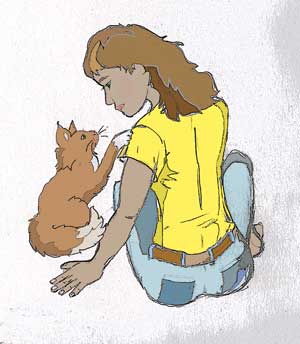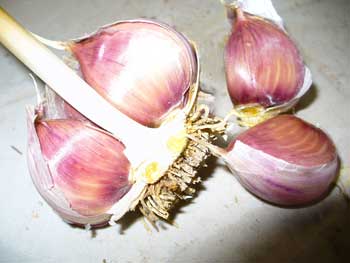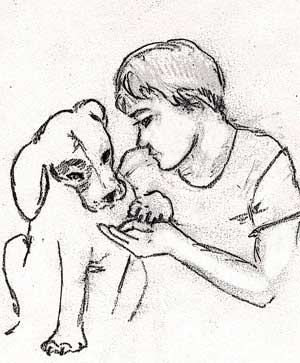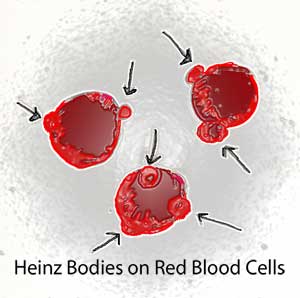Can You Give Garlic to Your Pet?

People want to give their pets the same holistic and natural supplements that they themselves enjoy. However, just because a food is tasty to humans doesn’t mean it is good for pets. In spite of what your darling kitty Mr. Muffin has been telling you, pets are not tiny royal humans in a fur suit. Humans and animals can have completely different reactions to the same food or supplement.
The garlic which many of us regard to be smelly ambrosia from the gods may be harmful to Fido, Princess or Thumper. Official guidelines say a small amount of garlic is okay for dogs, cats and horses. However, several published studies raise concerns about whether garlic should be fed to pets, specifically cats and dogs.
This has led to a rash of internet fear mongering and inaccurate information on pets and garlic consumption (No, you say! Inaccurate information on the internet! Say it isn't so!) Much of the confusion has been about safe dosage. Many sites prefer to err on the cautious side but I believe that you can assess the facts yourself and make your own choice.
First: Official Recommendations
A 2008 National Research Council report looked at garlic supplementation in pets (dogs, cats and horses). Due to inadequate research the council was unable to determine the safe upper limit of garlic intake for pets. However, they did use available research to recommend a range of acceptable intakes according to historical safe intakes (HSI) and estimated presumed safe intakes (PSI). The daily PSI and HIS is given in milligrams per kilogram of body weight (mg/kg BW):
Dogs:
PSI is 56 mg/kg BW (25.5 mg/lb BW). According to the National Research Council, "garlic has a long history of safe use as a supplement, with mean levels of 22 mg/kg BW being reported without serious adverse events".
Example: Spot weighs 50 lbs (BW) so the recommended maximum PSI garlic dose per day would be 50 lbs x 25.5 mg = 1,275 mg/day or 1.2 g/day (or 0.045 ounce/day). To be safe you should feed less than the maximal amount.
Cats:
Due to insufficient research data on felines and garlic the National Research Council committee was unable to establish a garlic PSI for cats. However, mean intake levels of 17 mg/kg BW (7.7 mg/lb BW) of garlic have been reported with no serious adverse events. Cats are more sensitive to alliums than dogs so be careful with your purry friend.
Example: Fluffy weighs 15 lbs so the recommended maximum amount of garlic a day would be 15 lbs x 7.7 mg/lb BW = 115.5 mg/day or 0.12 g/day (or 0.004 ounce/day). As with Spot, caution would dictate feeding less than the maximal amount.
Horses:
PSI is 90 mg/kg BW (41 mg/lb BW), with an HSI of 15 mg/kg BW (6.8 mg/lb BW).
Example: Socks weighs 850 lbs so the recommended maximum amount of garlic a day would be 850 x 41 mg/lb BW = 34,850 mg/day or 34.8 g/day (1.2 ounces/day).
Warning: Be careful of wild onion growing in the horse pasture. In one case a horse given 1-4 pound of wild onion tops a day for 11 days lost 60% of his red blood cells (RBCs) due to HzB formation and lysis! Although this is not a reliable experiment since the sample size was one, it does caution horse owners to be mindful.
1 ounce = 28.4 g or 28,400 mg
1 clove garlic = You need to weigh your garlic cloves to get the dosage right.
 Warning: Random musing interjected with odd facts follow -
Warning: Random musing interjected with odd facts follow -
Typically cloves can weigh anything from 4-30 grams. Store bought garlic is normally on the smaller size (4-8 g cloves) while hardneck garlic can have cloves sized from 4-30 g.
I have weighed cloves over 1.5 ounce (around 43 g). I don't know about you, but as a gardener I can't resist the urge to weigh or measure a large clove and then carry it around proudly showing it to everyone! "Look Mom, I grew it myself!" Luckily I work with my mom so she is right there to see it.
Second: Scary Study on Why Garlic May Be Fido’s Kryptonite
Four dogs given the equivalence of 5,000 mg/kg whole garlic (1.25 ml/kg garlic extract) directly by tube into their stomachs for 7 days developed some signs of RBC destruction (including lower RBC counts, less hemoglobin, more Heinz bodies and oxidized hemoglobin). Four dogs given water the same way did not develop any changes. No dogs developed hemolytic anemia (Lee et al. 2000).
Some limitations of this study were: the really small sample size (8 dogs total, only four given the garlic) and the very high amount of garlic given to the dogs. To compare this study to the recommendation above: in this study a 50 lb dog would be consuming 113,636 mg (113.6 grams or almost 1/4 pound) whole garlic a day! That is a lot of garlic.
I also came across a report of a 6 year old Schnauzer who developed hypertension (systolic mean 182 mmHg) along with vomiting and dark brown urination from accidental consumption of baked garlic. Other clinical indicators were regenerative anemia (hematocrit 22%), elevated methemoglobin (8.7%) concentration, eccentrocytes, Heinz bodies and ruptured red blood cells. the veterinarians guessed that these were the results from the oxidative injury from eating garlic. The dog was treated and recovered (Kang and Park 2010).
Why You Need to be Careful When Feeding Pets Garlic or Onions
 Excess garlic or onion intake can cause hemolytic anemia in horses, dogs, and cats. This adverse effect has not been reported in humans (our RBCs are different).
Excess garlic or onion intake can cause hemolytic anemia in horses, dogs, and cats. This adverse effect has not been reported in humans (our RBCs are different).
Onion and garlic contain sulfur compounds that can act as oxidizing agents. Onions have several forms of sulfur including n-propyl disulfate and several variations of sodium n-propyl thiosulfate. Garlic contains the oxidative agent 2-propenyl thiosulfate. These sulfur compounds can act as free radicals in the body by bounding to other substances. N-propyl disulfate and thiosulfate oxidize the hemoglobin in red blood cells (RBC) causing it to clump. These hemoglobin clumps are called Heinz bodies.
Heinz bodies are known to their close friends and overly familiar veterinarians as HzB (which sounds suspiciously like a popular music group). HzB stick out from the cell wall and can cause the RBC to rupture. In addition, the bulging HzB distort the shape of the RBC leading to changes in intracellular fluidity and alterations in the way the spleen processes RBCs. The spleen normally removes damaged RBCs from the circulation but in this case to many RBCs would be removed due to the lumpy HzB fooling the spleen. This whole cycle can lead to hemolytic anemia. This doesn't happen to humans because our RBCs are more resistant to oxidation than our pet's RBCs.
Hemolytic anemia is the accelerated breakdown or destruction of RBC. When RBCs break down they form bile and hemoglobin. These compounds are very strongly pigmented and will turn the animal’s eyes and skin yellow (jaundice) and the urine dark brown (hemoglobinuria). The animal may be weak and pale with a rapid pulse. In severe cases, fever and seizures may occur. Some animals are more at risk for this disorder. Female dogs are 4X more at risk than male dogs. In addition, cats are much more susceptible to the formation of HzB.
RBCs protect against oxidation by using an internal antioxidant, reduced glutathione. Glutathione sacrifices itself to neutralize free radicals like sulfur compounds. As RBCs age their supply of internal antioxidants runs out and they are more susceptible to free radicals.
Most scientist believe that n-propyl disulphide, found in onions, reduces the activity of glucose-6-phosphate dehydrogenase in RBCs. This inhibits regeneration of the reduced glutathione needed to prevent oxidative denaturation of hemoglobin in the RBCs. In other words, antioxidant supply decreases so cells are more susceptible to rupture and HzB formation.
Side note: humans with genetic deficiency of glucose-6-phosphate dehydrogenase are susceptible to hemolytic anemia (favism) from different causes including eating fava beans and excess stress.
Warning: Onions contain large amounts of harmful sulfur compounds (over 15x the amount in garlic) and should never be fed to pets. Some dogs can have a bad reaction from one onion. Cat food with a 3% formulation of onion powder caused HzB formation in kitties.
Treatment: Hemolytic anemia can be fatal; if you think your pet has hemolytic anemia please take him or her to the veterinarian. Typically the animal needs treatment with corticosteroids and immunosuppressants to halt the destruction of RBC. Severe cases may need a blood transfusion.
Take Home Message
According to the National Research Council recommendation and current research garlic is safe for healthy pets in small doses. Make sure to follow their recommendations above if you give garlic to your pet. Many pet owners give small amounts of fresh or powdered garlic to their dogs with no ill effects, however, some people don't think it is worth the risk. You need to weigh the evidence and do what you feel is best for you and your pet.
If you feed garlic to your pets, be careful of dosage. Cloves all have different weights. Weigh anything you give to your pet so that you know the dosage. Cats are more sensitive than dogs.
Do not give garlic to any animal you believe may be susceptible to hemolytic anemia, animals with a genetic tendency towards anemia, or any pet that has problems with anemia. If you do choose to feed garlic, watch your pet to make sure garlic agrees with them. Keep those garlic braids above Fido’s reach; don’t let your pet chow down on your garlic stash. If your dog or cat consumes a large amount of garlic you may want to take them to the veterinarian. Watch out for signs of hemolytic anemia.
Other Substances that Can Cause Hemolytic Anemia
Besides onions, commonly used products such acetaminophen (Tylenol) and benzocaine-containing topical preparations can cause hemolytic anemia.
In cats: the following products have been shown to contribute to hemolytic anemia:
- Onions (sulfates): see why above.
- Acetaminophen (Tylenol): Never give a cat acetaminophen or leave pills lying about where kitty can reach them; 50-60 mg/kg can be FATAL to your cat.
- Propylene glycol (carbohydrate food source, preservative in moist CAT and pet food): Propylene glycol does not cause oxidative damage itself. However, when propylene glycol is metabolized it creates adelhyde intermediates that react with amino and sulfhydryl groups on the hemoglobin molecule. Cats on diets containing propylene glycol are more susceptible to oxidative stress than cats on a propylene glycol free diet (Christopher et al. 1990). You may want to read your pet food ingredient label.
- Benzocaine products (used for itching and/or to numb pain in people and pets).
- Other products that may cause hemolytic anemia: propofol (used as an induction agent to anesthetize animals), phenols, methylene blue (urinary antiseptic, IV contrast dye), d-L methionine, vitamin K3 (>2.5 mg/lb/day), phenazopyridine (urinary analgesic), naphthalene, and the minerals zinc and copper.
- Sources: Weiss et al. 1990, , Houston and Myers 1993, Desnoyers 2000, Giger 2000, Kovalkovičová et al. 2009.
Dogs: HzB were induced by consumption of onions, methylene blue, acetaminophen, zinc, benzocaine, vitamin K, phenylhydrazine (Houston and Myers, 1993, Kovalkovičová et al. 2009).
References:
- Christopher MM, White JG, Eaton JW. Erythrocyte pathology and mechanisms of Heinz body-mediated hemolysis in cats. Vet Pathol. 1990;27:299-310. Pubmed. Full text.
- Desnoyers M. Anemias associated with heinz bodies. Schalm's Veterinary Hematology, 5th ed. Feldman BF, Zinkl JG, Jain NC (eds). Baltimore, Lippincott Williams & Wilkins. 2000;pp. 178-180.
- Giger U. Regenerative anemias caused by blood loss or hemolysis. Textbook of Veterinary Internal Medicine, 5th ed., Ettinger SJ, Feldman EC (eds). Philadelphia, W.B. Saunders Company, 2000, pp.1801-1802.
- Houston DM, Myers SL. A review of Heinz-body anemia in the dog induced by toxins. Vet Hum Toxicol. 1993;35:158–161. Pubmed.
- Kang MH, Park HM. Hypertension after ingestion of baked garlic (Allium sativum) in a dog. J Vet Med Sci. 2010;72:515-8. Pubmed. Full text.
- Kovalkovičová N, Irena Šutiaková, Juraj Pistl, and Václav Šutiak. Some food toxic for pets. Interdiscip Toxicol. 2009;2:169–176. Pubmed. Full text.
- Lee KW, Yamato O, Tajima M, Kuraoka M, Omae S, Maede Y. Hematologic changes associated with the appearance of eccentrocytes after intragastric administration of garlic extract to dogs. Am J Vet Res. 2000;61:1446-50. Pubmed.
- National Academy of Sciences (2008, August 22). Dietary Supplements For Horses, Dogs And Cats Need Better Regulation, New Report Says. ScienceDaily. Retrieved February 9, 2013
- Weiss DJ, McClay CB, Christopher MM, Murphy M, Perman V. Effects of propylene glycol-containing diets on acetaminophen-induced methemoglobinemia in cats. J Am Vet Med Assoc. 1990:196:1816-1819. Pubmed.
